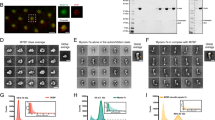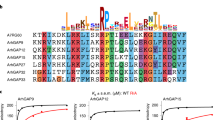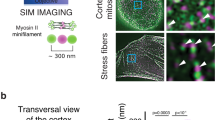Abstract
GTPases of the Rho family regulate actinomyosin-based contraction in non-muscle cells. Activation of Rho increases contractility, leading to cell rounding and neurite retraction in neuronal cell lines. Activation of Rac promotes cell spreading and interferes with Rho-mediated cell rounding. Here we show that activation of Rac may antagonize Rho by regulating phosphorylation of the myosin-II heavy chain. Stimulation of PC12 cells or N1E-115 neuroblastoma cells with bradykinin induces phosphorylation of threonine residues in the myosin-II heavy chain; this phosphorylation is Ca2+ dependent and regulated by Rac. Both bradykinin-mediated and constitutive activation of Rac promote cell spreading, accompanied by a loss of cortical myosin II. Our results identify the myosin-II heavy chain as a new target of Rac-regulated kinase pathways, and implicate Rac as a Rho antagonist during myosin-II-dependent cell-shape changes.
This is a preview of subscription content, access via your institution
Access options
Subscribe to this journal
Receive 12 print issues and online access
$209.00 per year
only $17.42 per issue
Buy this article
- Purchase on Springer Link
- Instant access to full article PDF
Prices may be subject to local taxes which are calculated during checkout





Similar content being viewed by others
References
Amano, M. et al. Phosphorylation and activation of myosin by Rho-associated kinase (Rho-kinase). J. Biol. Chem. 271, 20246–20249 (1996).
Kimura, K. et al. Regulation of myosin phosphatase by Rho and Rho-associated kinase (Rho-kinase). Science 273, 245–248 (1996).
Jalink, K., Hengeveld, T., Morii, N., Narumiya, S. & Moolenaar, W. H. Inhibition of lysophosphatidate- and thrombin-induced neurite retraction and neuronal cell rounding by ADP ribosylation of the small GTP-binding protein Rho. J. Cell Biol. 126, 801–810 (1994).
Hirose, M. et al. Molecular dissection of the Rho-associated protein kinase (p160ROCK)- regulated neurite remodeling in neuroblastoma N1E-115 cells. J. Cell Biol. 141, 1625–1636 (1998).
van Leeuwen, F. N. et al. The guanine nucleotide exchange factor Tiam1 affects neuronal morphology; opposing roles for the small GTPases Rac and Rho. J. Cell Biol. 139, 797–807 (1997).
Kozma, R., Sarner, S., Ahmed, S. & Lim, L. Rho family GTPases and neuronal growth cone remodeling: relationship between increased complexity induced by Cdc42 Hs, Rac1 and acetylcholine, and collapse induced by RhoA and lysophosphatidic acid. Mol. Cell. Biol. 17, 1201–1211 (1997).
Lim, L., Manser, E., Leung, T. & Hall, C. Regulation of phosphorylation pathways by p21 GTPases. Eur. J. Biochem. 242, 171–185 (1996).
Sander, E. E. et al. Matrix-dependent Tiam1/Rac signaling in epithelial cells promotes either cell-cell adhesion or cell migration and is regulated by phosphatidylinositol 3-kinase. J. Cell Biol. 143, 1385–1398 (1998).
Manser, E., Leung, T., Salihuddin, H., Zhao, Z. S. & Lim, L. A brain serine/threonine protein kinase activated by Cdc42 and Rac1. Nature 367, 40–46 (1994).
Michiels, F., Habets, G. G. M., Stam, J. C., Van der Kammen, R. A. & Collard, J. G. A role for Rac-1 in Tiam1 induced membrane ruffling and T-lymphoma invasion. Nature 375, 338–340 (1995).
Kozma, R., Ahmed, S., Best, A. & Lim, L. The Ras-related protein Cdc42HS and Bradykinin promote the formation of peripheral actin microspikes and filopodia in Swiss 3T3 fibroblasts. Mol. Cell. Biol. 15, 1942–1952 (1995).
Nobes, C. D. & Hall, A. Rho, Rac and Cdc42 GTPases regulate the assembly of multi-molecular focal complexes associated with actin stress fibers, lamellipodia and filopodia. Cell 81, 53–62 (1995).
Sells, M. A. et al. Human p21-activated kinase (Pak1) regulates actin organization in mammalian cells. Curr. Biol. 7, 202–210 (1997).
Manser, E. et al. Expression of constitutively active alpha-PAK reveals effects of the kinase on actin and focal complexes. Mol. Cell Biol. 17, 1129–1143 (1997).
Daniels, R. H., Hall, P. S. & Bokoch, G. M. Membrane targeting of p21-activated kinase 1 (PAK1) induces neurite outgrowth from PC12 cells. EMBO J. 17, 754–764 (1998).
Tang, Y. et al. Kinase deficient Pak1 mutants inhibit Ras transformation of Rat-1 fibroblasts. Mol. Cell. Biol. 17, 4454–4464 (1997).
King, A. J. et al. The protein kinase Pak3 positively regulates Raf-1 activity through phosphorylation of serine 338. Nature 396, 180–183 (1998).
Fasolato, C., Pandiella, A., Meldolesi, J. & Pozzan, T. Generation of inositol phosphates, cytosolic Ca2+, and ionic fluxes in PC12 cells treated with bradykinin. J. Biol. Chem. 263, 17350–17359 (1988).
Zheng, J. Q., Felder, M., Connor, J. A. & Poo, M. M. Turning of nerve growth cones induced by neurotransmitters. Nature 368, 140–144 (1994).
Burridge, K. & Chrzanowska-Wodnicka, M. Focal adhesions, contractility, and signaling. Annu. Rev. Cell Dev. Biol. 12, 463–518 (1996).
Chrzanowska-Wodnicka, M. & Burridge, K. Rho-stimulated contractility drives the formation of stress fibers and focal adhesions. J. Cell Biol. 133, 1403–1415 (1996).
Tan, J. L., Ravid, S. & Spudich, J. A. Control of nonmuscle myosins by phosphorylation. Annu. Rev. Biochem. 61, 721–759 (1992).
Ludowyke, R. I., Peleg, I., Beaven, M. A. & Adelstein, R. S. Antigen-induced secretion of histamine and the phosphorylation of myosin by protein kinase C in rat basophilic leukemia cells. J. Biol. Chem. 264, 12492–12501 (1989).
Spudich, A. Myosin reorganization in activated RBL cells correlates temporally with stimulated secretion. Cell Motil. Cytoskeleton 29, 345–353 (1994).
Wilson, J. R., Ludowyke, R. I. & Biden, T. J. Nutrient stimulation results in a rapid Ca2+-dependent threonine phosphorylation of myosin heavy chain in rat pancreatic islets and RINm5F cells. J. Biol. Chem. 273, 22729–22737 (1998).
Brzeska, H. & Korn, E. D. Regulation of class I and class II myosins by heavy chain phosphorylation. J. Biol. Chem. 271, 16983–16986 (1996).
Egelhoff, T. T., Lee, R. J. & Spudich, J. A. Dictyostelium myosin heavy chain phosphorylation sites regulate myosin filament assembly and localization in vivo. Cell 75, 363–371 (1993).
Murakami, N., Chauhan, V. P. & Elzinga, M. Two nonmuscle myosin II heavy chain isoforms expressed in rabbit brains: filament forming properties, the effects of phosphorylation by protein kinase C and casein kinase II, and location of the phosphorylation sites. Biochemistry 37, 1989–2003 (1998).
Mitchison, T. J. & Cramer, L. P. Actin-based cell motility and cell locomotion. Cell 84, 371–379 (1996).
Peppelenbosch, M. P. et al. Rac-dependent and -independent pathways mediate growth factor-induced Ca2+ influx. J. Biol Chem. 271, 7883–7886 (1996).
Lee, S. F., Egelhoff, T. T., Mahasneh, A. & Cote, G. P. Cloning and characterization of a Dictyostelium myosin I heavy chain kinase activated by Cdc42 and Rac. J. Biol Chem. 271, 27044–27048 (1996).
Brzeska, H., Szczepanowska, J., Hoey, J. & Korn, E. D. The catalytic domain of acanthamoeba myosin I heavy chain kinase. II. Expression of active catalytic domain and sequence homology to p21- activated kinase (PAK). J. Biol Chem. 271, 27056–27062 (1996).
Wu, C. et al. Activation of myosin-I by members of the Ste20p protein family. J. Biol Chem. 271, 31787–31790 (1996).
Sanders, L. C., Matsumura, F., Bokoch, G. M. & de Lanerolle, P. Inhibition of myosin light chain kinase by p21-activated kinase. Science 283, 2083–2085 (1999).
Sells, M. A., Boyd, J. T. & Chernoff, J. p21-activated kinase 1 (Pak1) regulates cell motility in mammalian fibroblasts. J. Cell Biol. 145, 837–849 (1999).
Burridge, K. Crosstalk between Rac and Rho. Science 283, 2028–2029 (1999).
Ramos, E., Wysolmerski, R. B. & Masaracchia, R. A. Myosin phosphorylation by human cdc42-dependent S6/H4 kinase/gammaPAK from placenta and lymphoid cells. Recept. Signal Transduct. 7, 99–110 (1997).
Van Eyk, J. E. et al. Different molecular mechanisms for Rho family GTPase-dependent, Ca2+- independent contraction of smooth muscle. J. Biol Chem. 273, 23433–23439 (1998).
Yablonski, D., Kane, L. P., Qian, D. & Weiss, A. A Nck-Pak1 signaling module is required for T-cell receptor-mediated activation of NFAT, but not of JNK. EMBO J. 17, 5647–5657 (1998).
Kinsella, T. M. & Nolan, G. P. Episomal vectors rapidly and stably produce high-titer recombinant retrovirus. Hum. Gene Ther. 7, 1405–1413 (1996).
Kelley, C. A. et al. Xenopus nonmuscle myosin heavy chain isoforms have different subcellular localizations and enzymatic activities. J. Cell Biol. 134, 675–687 (1996).
Acknowledgements
We thank A. Hall for providing Rac and Rho cDNAs; G. Nolan for providing phoenix eco- and amphotrophic packaging cells and LZRS retroviral vectors; and L.Oomen and N. Ong for help in making the figures. This work was supported by grants from the Dutch Cancer Society to J.G.C.
Correspondence and requests for materials should be addressed to J.G.C.
Author information
Authors and Affiliations
Corresponding author
Rights and permissions
About this article
Cite this article
van Leeuwen, F., van Delft, S., Kain, H. et al. Rac regulates phosphorylation of the myosin-II heavy chain, actinomyosin disassembly and cell spreading. Nat Cell Biol 1, 242–248 (1999). https://doi.org/10.1038/12068
Received:
Revised:
Accepted:
Published:
Issue Date:
DOI: https://doi.org/10.1038/12068
This article is cited by
-
Rab6 regulates cell migration and invasion by recruiting Cdc42 and modulating its activity
Cellular and Molecular Life Sciences (2019)
-
Integrin-Dependent Regulation of Small GTPases: Role in Cell Migration
Journal of the Indian Institute of Science (2017)
-
Rac1 GTPase-deficient HeLa cells present reduced DNA repair, proliferation, and survival under UV or gamma irradiation
Molecular and Cellular Biochemistry (2015)
-
Phospholipase C, Ca2+, and calmodulin signaling are required for 5-HT2A receptor-mediated transamidation of Rac1 by transglutaminase
Psychopharmacology (2011)
-
Rac and Rho GTPases in cancer cell motility control
Cell Communication and Signaling (2010)



